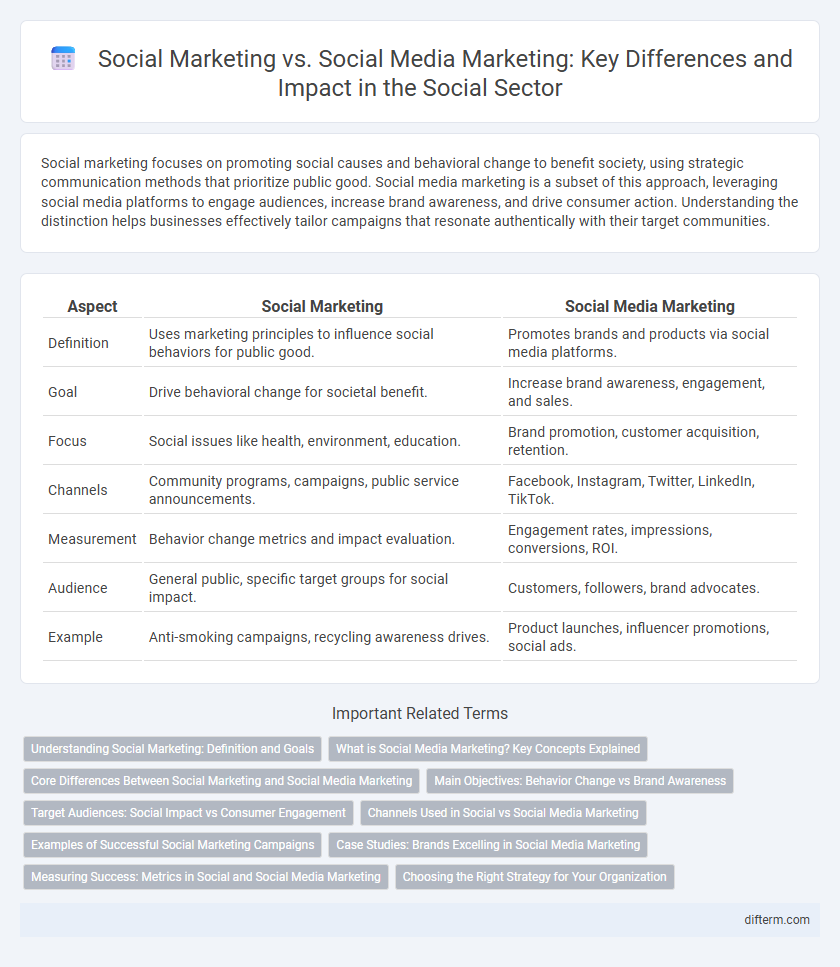Social marketing focuses on promoting social causes and behavioral change to benefit society, using strategic communication methods that prioritize public good. Social media marketing is a subset of this approach, leveraging social media platforms to engage audiences, increase brand awareness, and drive consumer action. Understanding the distinction helps businesses effectively tailor campaigns that resonate authentically with their target communities.
Table of Comparison
| Aspect | Social Marketing | Social Media Marketing |
|---|---|---|
| Definition | Uses marketing principles to influence social behaviors for public good. | Promotes brands and products via social media platforms. |
| Goal | Drive behavioral change for societal benefit. | Increase brand awareness, engagement, and sales. |
| Focus | Social issues like health, environment, education. | Brand promotion, customer acquisition, retention. |
| Channels | Community programs, campaigns, public service announcements. | Facebook, Instagram, Twitter, LinkedIn, TikTok. |
| Measurement | Behavior change metrics and impact evaluation. | Engagement rates, impressions, conversions, ROI. |
| Audience | General public, specific target groups for social impact. | Customers, followers, brand advocates. |
| Example | Anti-smoking campaigns, recycling awareness drives. | Product launches, influencer promotions, social ads. |
Understanding Social Marketing: Definition and Goals
Social marketing focuses on influencing behaviors to improve individual and community well-being, leveraging strategies that promote social good rather than commercial profit. Its primary goals include raising awareness, changing attitudes, and encouraging positive actions related to health, environment, and social issues. Unlike social media marketing, which targets brand promotion and customer engagement through digital platforms, social marketing centers on behavioral change for societal benefit.
What is Social Media Marketing? Key Concepts Explained
Social media marketing involves using platforms like Facebook, Instagram, Twitter, and LinkedIn to promote brands, engage with customers, and drive website traffic through targeted content and advertising campaigns. Key concepts include content creation, audience targeting, social media analytics, influencer collaboration, and paid advertising strategies designed to boost brand visibility and conversions. Unlike broader social marketing, which encompasses societal behavior change initiatives, social media marketing focuses specifically on leveraging digital social networks for commercial objectives.
Core Differences Between Social Marketing and Social Media Marketing
Social marketing centers on promoting social good by influencing behaviors for societal benefit, often employing strategies based on psychology and public policy. In contrast, social media marketing focuses on leveraging social media platforms to enhance brand awareness, engage audiences, and drive sales through targeted advertising and content creation. Core differences include the objectives--social marketing targets behavior change for community welfare, while social media marketing aims at commercial growth and customer interaction.
Main Objectives: Behavior Change vs Brand Awareness
Social marketing primarily aims to influence behavior change by promoting social good, such as healthier lifestyles or environmental conservation, targeting long-term societal benefits. Social media marketing focuses on increasing brand awareness, customer engagement, and driving sales through platforms like Facebook, Instagram, and Twitter. While social marketing measures success by shifts in public behavior and attitudes, social media marketing emphasizes metrics like reach, impressions, and conversion rates.
Target Audiences: Social Impact vs Consumer Engagement
Social marketing targets specific audiences to promote social change by addressing behaviors that benefit society, focusing on raising awareness and influencing attitudes. Social media marketing aims at consumer engagement, leveraging platforms like Facebook and Instagram to drive brand loyalty, sales, and direct interaction with potential buyers. Understanding these distinctions allows marketers to tailor content that either fosters social impact or maximizes consumer participation effectively.
Channels Used in Social vs Social Media Marketing
Social marketing employs a diverse range of channels, including community programs, public service announcements, and offline outreach alongside digital platforms, to promote social causes and behavioral change. Social media marketing primarily leverages digital platforms such as Facebook, Instagram, Twitter, LinkedIn, and TikTok for targeted advertising and brand engagement. This distinction highlights social marketing's multi-channel approach versus social media marketing's exclusive focus on social networking sites.
Examples of Successful Social Marketing Campaigns
Successful social marketing campaigns like the ALS Ice Bucket Challenge raised awareness and funds for ALS research by encouraging user participation and viral sharing. Dove's "Real Beauty" campaign promoted body positivity and self-esteem, effectively shifting social norms through emotional storytelling and inclusive imagery. The "Trash Isles" campaign leveraged social media to highlight ocean pollution, engaging millions in a global movement to recognize plastic waste as a country and prompt environmental action.
Case Studies: Brands Excelling in Social Media Marketing
Leading brands like Nike and Starbucks leverage targeted social media marketing campaigns to drive engagement, using platforms such as Instagram and TikTok to create personalized content that resonates with younger audiences. Case studies reveal how social media marketing surpasses traditional social marketing by enabling real-time interaction and data-driven strategies that boost brand loyalty and conversion rates. Analyzing these successful campaigns highlights the critical role of influencer partnerships and viral content in amplifying reach and impact on consumer behavior.
Measuring Success: Metrics in Social and Social Media Marketing
Measuring success in social marketing involves tracking engagement rates, brand sentiment, and community growth to assess how well campaigns resonate with target audiences. Social media marketing metrics focus on click-through rates, conversion rates, and follower growth analytics to evaluate platform-specific performance and ROI. Combining these data points provides a comprehensive understanding of campaign effectiveness across broader social strategies and targeted digital channels.
Choosing the Right Strategy for Your Organization
Social marketing focuses on influencing behaviors for social good using strategic messaging and community engagement, while social media marketing leverages digital platforms to promote products or services and drive brand awareness. Choosing the right strategy depends on organizational goals, target audience, and desired outcomes, with social marketing suited for public health, environmental campaigns, and social change, whereas social media marketing fits commercial objectives and customer acquisition. Effective integration of both strategies can amplify impact by combining behavior change techniques with broad digital reach.
social marketing vs social media marketing Infographic

 difterm.com
difterm.com